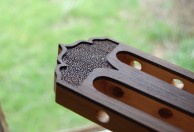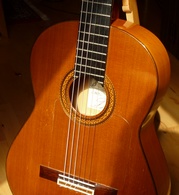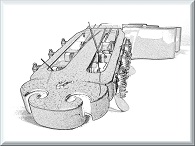Welcome to one of the most active flamenco sites on the Internet. Guests can read most posts but if you want to participate click here to register.
This site is dedicated to the memory of Paco de Lucía, Ron Mitchell, Guy Williams, Linda Elvira, Philip John Lee, Craig Eros, Ben Woods, David Serva and Tom Blackshear who went ahead of us.
We receive 12,200 visitors a month from 200 countries and 1.7 million page impressions a year. To advertise on this site please contact us.
|

|
|
Why?
|
You are logged in as Guest
|
|
Users viewing this topic: none
|
|
Login  | |
|

   
Richard Jernigan
Posts: 3430
Joined: Jan. 20 2004
From: Austin, Texas USA

|
 RE: Why? (in reply to Ruphus) RE: Why? (in reply to Ruphus)
|
|
|
quote:
ORIGINAL: Ruphus
... and that most of chopped down BR is to become fragrance for parfumes.
Ruphus
From C. F. Vega at
http://www.acousticguitar.com/ubbcgi/ultimatebb.cgi?ubb=get_topic;f=7;t=010641#000000
"I've read a number of articles, both on the internet and in print, stating that the use of "Brazilian rosewood oil" by the perfume/fragrance industry has contributed in large part to the near extinction, international trade bans and resulting exhorbitant prices of Dalbergia nigra, the true Brazilian rosewood of lore and legend.
Nonsense. Poppycock. Balderdash. Horsehockey.
The tree that is the source of the so-called "Brazilian rosewood oil" that is used in fragrances is a large evergreen with the botanical name Aniba rosaeodora that grows in the western Amazon basin as well as in Peru, Chile, Ecuador and a couple of other countries but Brazil is the primary supplier. The tree that is the source of the Brazilian rosewood that we all know (or at least think we know) and love grows only in the Mata Atlantica, the Atlantic coastal forest of Brazil and not in the Amazon basin. They are two separate and distinct trees of different botanic genera and are not related to each other.
While the widespread harvesting of A. rosaeodora may well be a contributing factor to the decimation of the Amazon rainforest, it has no bearing whatsoever on the rarity of D. nigra.
This is just one more example of a common/colloquial term causing confusion. The term "Brazilian rosewood" has been used for many years to describe any number of woods, some from Brazil, some not. Some are botanically true rosewoods (genus Dalbergia), others are not. While it is true that there are other species of the genus Dalbergia that grow in Brazil and therefore could correctly be called "Brazilian rosewood" (but usually aren't while several non-Dalbergia species often are ), the one that is near and dear to the hearts of guitar makers and players and the one that is the Big Enchilada on the CITES and Lacey Act lists is D. nigra, not some sort of look-alike, smell-alike, taste-alike, etc.
The genus Dalbergia is quite large and while there is some dispute as to the actual number of species within the genus, the number is probably in excess of 300. While all of the true rosewoods are of this genus, there are only about a dozen or so species worldwide that yield commercially viable lumber. Some of the species are little more than small shrubs. In other words, all of the true rosewoods are Dalbergias but not all Dalbergias are rosewoods.
Bottom line----The tree that is the source of "Brazilian rosewood oil" is not actually a rosewood at all, the fragrance industry has nothing whatsoever to do with the scarcity of D. nigra and D. nigra, while a fragrant wood insofar as woods go, is not used for making perfume."
RNJ
|
|
|
|
REPORT THIS POST AS INAPPROPRIATE |
Date Feb. 19 2011 23:59:14
 |
|

 
tamoio
Posts: 20
Joined: Feb. 7 2011
From: mostly Alaska

|
 RE: Why? (in reply to Richard Jernigan) RE: Why? (in reply to Richard Jernigan)
|
|
|
quote:
ORIGINAL: Richard Jernigan
quote:
ORIGINAL: Ruphus
... and that most of chopped down BR is to become fragrance for parfumes.
Ruphus
From C. F. Vega at
http://www.acousticguitar.com/ubbcgi/ultimatebb.cgi?ubb=get_topic;f=7;t=010641#000000
"I've read a number of articles, both on the internet and in print, stating that the use of "Brazilian rosewood oil" by the perfume/fragrance industry has contributed in large part to the near extinction, international trade bans and resulting exhorbitant prices of Dalbergia nigra, the true Brazilian rosewood of lore and legend.
Nonsense. Poppycock. Balderdash. Horsehockey.
The tree that is the source of the so-called "Brazilian rosewood oil" that is used in fragrances is a large evergreen with the botanical name Aniba rosaeodora that grows in the western Amazon basin as well as in Peru, Chile, Ecuador and a couple of other countries but Brazil is the primary supplier. The tree that is the source of the Brazilian rosewood that we all know (or at least think we know) and love grows only in the Mata Atlantica, the Atlantic coastal forest of Brazil and not in the Amazon basin. They are two separate and distinct trees of different botanic genera and are not related to each other.
While the widespread harvesting of A. rosaeodora may well be a contributing factor to the decimation of the Amazon rainforest, it has no bearing whatsoever on the rarity of D. nigra.
This is just one more example of a common/colloquial term causing confusion. The term "Brazilian rosewood" has been used for many years to describe any number of woods, some from Brazil, some not. Some are botanically true rosewoods (genus Dalbergia), others are not. While it is true that there are other species of the genus Dalbergia that grow in Brazil and therefore could correctly be called "Brazilian rosewood" (but usually aren't while several non-Dalbergia species often are ), the one that is near and dear to the hearts of guitar makers and players and the one that is the Big Enchilada on the CITES and Lacey Act lists is D. nigra, not some sort of look-alike, smell-alike, taste-alike, etc.
The genus Dalbergia is quite large and while there is some dispute as to the actual number of species within the genus, the number is probably in excess of 300. While all of the true rosewoods are of this genus, there are only about a dozen or so species worldwide that yield commercially viable lumber. Some of the species are little more than small shrubs. In other words, all of the true rosewoods are Dalbergias but not all Dalbergias are rosewoods.
Bottom line----The tree that is the source of "Brazilian rosewood oil" is not actually a rosewood at all, the fragrance industry has nothing whatsoever to do with the scarcity of D. nigra and D. nigra, while a fragrant wood insofar as woods go, is not used for making perfume."
RNJ
Thanks Richard.
I'll also add that to my knowledge the primary source regions for Dalbergia nigra , the "Mata Atlantica" that you mention would be places like coastal Pernambuco or Bahia. These areas have been heavily cleared for plantation agriculture beginning in the 16th century. There are still sizeable pockets of "Mata Atlantica" even in Rio de Janeiro state, but at the time of european contact it stretched unbroken from the Rio Plata to the Yucatan. I'm certain that, at least initially, Brasilian "rosewood" was not coming from the Amazon Basin.
_____________________________
"The TV business is a cruel and shallow money trench, a long plastic hallway where thieves and pimps run free, and good men die like dogs. . .Then there's also the negative side"
Hunter S. Thompson
|
|
|
|
REPORT THIS POST AS INAPPROPRIATE |
Date Feb. 20 2011 19:13:35
 |
|
 New Messages New Messages |
 No New Messages No New Messages |
 Hot Topic w/ New Messages Hot Topic w/ New Messages |
 Hot Topic w/o New Messages Hot Topic w/o New Messages |
 Locked w/ New Messages Locked w/ New Messages |
 Locked w/o New Messages Locked w/o New Messages |
|
 Post New Thread
Post New Thread
 Reply to Message
Reply to Message
 Post New Poll
Post New Poll
 Submit Vote
Submit Vote
 Delete My Own Post
Delete My Own Post
 Delete My Own Thread
Delete My Own Thread
 Rate Posts
Rate Posts
|
|
|
Forum Software powered by ASP Playground Advanced Edition 2.0.5
Copyright © 2000 - 2003 ASPPlayground.NET |
0.078125 secs.
|


 Printable Version
Printable Version













 New Messages
New Messages No New Messages
No New Messages Hot Topic w/ New Messages
Hot Topic w/ New Messages Hot Topic w/o New Messages
Hot Topic w/o New Messages Locked w/ New Messages
Locked w/ New Messages Locked w/o New Messages
Locked w/o New Messages Post New Thread
Post New Thread